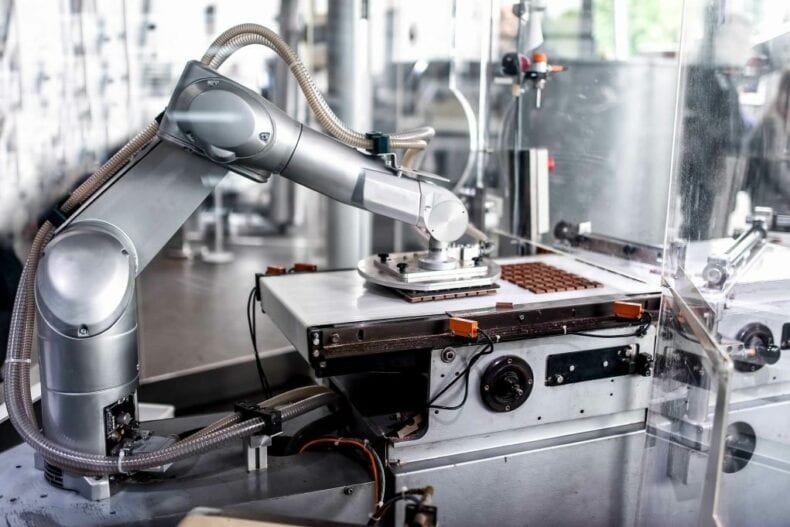In the fast growing logistics industry, robotic automation stands as a cornerstone for operational excellence. Our article “Robotic Automation for Logistic Hubs” presents an in-depth analysis of this technological revolution.
At L-A-C Logistics Automation, with our extensive experience in the sector, we focus on how automation streamlines efficiency, accuracy, and scalability in logistics environments.
This article serves as an essential resource for professionals seeking to understand and implement robotic solutions in their logistics operations, offering a clear perspective on the transformative impact of robotics in the logistics industry.
What is Robotic Automation and How Can it Help Logistic Hubs
Robotic Automation refers to the use of advanced robotic systems to perform a variety of tasks in logistics hubs. This technology encompasses everything from automated guided vehicles (AGVs) and robotic arms, to sophisticated software systems that control and optimise logistics processes. At its core, robotic automation is designed to enhance operational efficiency, reduce manual errors, and streamline workflows.
In logistic hubs, where speed and accuracy are paramount, robotic automation offers several transformative benefits. Firstly, it significantly speeds up material handling and packaging processes, directly impacting throughput rates. Secondly, it reduces the likelihood of human error, ensuring more consistent and reliable operations. Furthermore, robotic systems can operate continuously, increasing productivity and allowing human workers to focus on more strategic, less repetitive tasks.
Integrating robotic automation, logistic hubs can achieve a higher level of operational efficiency and accuracy, leading to improved customer satisfaction and competitive advantage in the fast-paced logistics sector.

The Role of Automation in Logistic Hubs
Automation in logistic hubs plays a pivotal role in enhancing the overall efficiency and effectiveness of supply chain operations. By integrating advanced robotic systems, logistic hubs can address several key operational challenges while optimising their processes.
One primary role of automation is to streamline inventory management. Robotic systems equipped with sensors and AI capabilities can swiftly and accurately track inventory levels, reducing the risk of stock discrepancies and enabling real-time inventory updates. This precision in inventory management is crucial for maintaining optimal stock levels and avoiding overstocking or stockouts.
Another critical role is in order fulfilment. Automated systems expedite the picking and packing process, significantly reducing the time from order receipt to shipment. This increase in speed does not compromise accuracy; in fact, it often enhances it, leading to fewer errors in order fulfilment.
Moreover, automation contributes to safer working conditions in logistic hubs. Robots can perform heavy lifting and repetitive tasks, reducing the physical strain on human workers and minimising the risk of workplace injuries. This not only improves safety but also boosts employee morale and productivity.
The role of automation in logistic hubs is multifaceted, addressing efficiency, accuracy, safety, and overall operational excellence. As logistic hubs continue to embrace these technological advancements, they are setting new standards in supply chain management and customer satisfaction.
The Advantages of Robotic Automation
Robotic automation in logistic hubs presents many advantages, significantly transforming how operations are conducted. Key benefits include:
Increased efficiency in handling and sorting goods
Robotics significantly accelerates the handling and sorting of goods. Automated systems, such as conveyor belts, sorting robots, and AGVs, work seamlessly to move products through the logistics chain with remarkable speed. This efficiency not only speeds up the processing time but also increases the overall throughput, enabling logistic hubs to handle higher volumes of goods more effectively.
Enhanced accuracy in inventory management
With robotic automation, inventory management becomes more precise. Automated systems equipped with advanced scanning and tracking technologies ensure that every item is accurately accounted for. This level of accuracy is vital in maintaining up-to-date inventory records, reducing the instances of misplaced or lost items, and ensuring that stock levels are always optimised.
Reduction in operational costs and labour requirements
One of the most significant advantages of robotic automation is the substantial reduction in operational costs and labour requirements. Robots can perform repetitive and labour-intensive tasks, which reduces the need for a large workforce. This not only cuts down on labour costs but also minimises human errors associated with these tasks. Additionally, robotic systems often operate with higher energy efficiency compared to manual operations, further reducing operational costs.
The implementation of robotic automation in logistic hubs brings about substantial improvements in efficiency, accuracy, and cost-effectiveness, making it a key driver in the evolution of modern logistics operations.

Key Technologies in Robotic Automation
Automated Guided Vehicles (AGVs)
AGVs are a cornerstone in the automation of logistic hubs. These self-guided vehicles are designed to transport goods around a facility without human intervention. Equipped with sensors and navigation technologies, AGVs efficiently move materials between different sections of the hub, reducing manual handling and increasing speed and safety in the transportation of goods.
Robotic Picking and Packing Systems
Robotic picking and packing systems revolutionise how items are picked and packed in logistic hubs. Using a combination of robotic arms, vision systems, and artificial intelligence, these systems can identify, pick, and package various items with remarkable precision and speed. This automation significantly enhances the efficiency of the order fulfilment process, ensuring that customer orders are processed quickly and accurately.
Conveyor and Sorting Systems
Conveyors and automated sorting systems are vital in managing the flow of goods through logistic hubs. These systems efficiently transport products from one point to another and sort them based on destination, size, type, or other predefined criteria. By automating these processes, logistic hubs can drastically reduce the time and effort required for manual sorting and transportation, further streamlining their operations.
The Future of Robotic Automation in Logistic Hubs
The future of robotic automation in logistic hubs is poised to be a landscape of continuous innovation and transformative impacts. Emerging trends like advanced AI, machine learning, and enhanced sensor technologies are set to make robotic systems more intelligent and adaptable, fostering even more efficient and sophisticated operations.
This progression is expected to sustain the growth trajectory of automation in logistics, not only in automating repetitive tasks but also in leveraging data-driven insights for strategic supply chain optimisation.
The societal and economic implications of this shift are significant, potentially leading to more efficient supply chains and new job opportunities, albeit altering the traditional employment landscape in the logistics industry.
This evolution promises to redefine the efficiency, capability, and reach of logistic hubs in the coming years, marking a new era in supply chain management.

Embrace the Future with L-A-C Logistics Automation
In summary, the integration of robotic automation into logistic hubs presents a landscape brimming with potential and advantages. We’ve seen how these advanced technologies can significantly enhance efficiency, accuracy, and reduce operational costs, reshaping the logistics industry’s future. As we stand on the brink of this transformative era, L-A-C Logistics Automation encourages logistic hubs to explore and embrace these automation solutions actively.
The potential of robotic automation in logistics is not just about adopting new technologies; it’s about stepping into a future where technology and human ingenuity combine to create more efficient, reliable, and sustainable logistic operations. If you’re ready to explore the possibilities and how they can revolutionise your operations, we at L-A-C Logistics Automation are here to guide and support you every step of the way.




